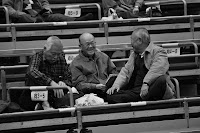Sumo! (own choice 3)
On the weekend, some friends and I made the long journey to Fukuoka to watch the sumo wrestling. The tournament is held at the Kokusai Centre and runs for 15 days. Most westerners are under the common misconception that you can watch a sumo match anytime in Japan. In fact, there are only 6 grand tournaments a year, 3 are held in Tokyo and 1 in Osaka, Nagoya and Kyushu. Sumo wrestlers or rikishi fight once everyday with a different opponent. The winner is the rikishi with the most wins compared to losses and is awarded with the emperor’s cup on the last day.
 |
| Sumo arriving at the Kokusai Center |
 |
| Before the sumo begin, they have a doyo-iri or entering the ring ceremony. |
At present there are 800 rikishi from trainee level to the highest, the yokozuna. Becoming a yokozuna is what every sumo trains for, but in the past 300 years since the title was created, only 69 rikishi have been honored. Once titled a yokozuna, he can never be demoted, even if he makes a bad showing during a tournament. If he continues to perform badly he is expected to retire.
 |
| Current yokozuna hakuho performs his dohyo-iri |
After following some good advice from a teacher, we decided to go on a weekday and buy the cheapest general admission seats. The arena didn’t start filling up until around 4pm, as people come to see the more famous acts that are on in the late afternoon. So we were able to sit really close and see all the action!
As we were there all day I did a lot of people watching, observing all the different people that attend sumo. Everyone from school children screaming for their favourite wrestler, adorable little old ladies with their bento, salary men, geisha or maiko, (we were not really sure) families and couples.
One of the highlights of the day was then crowed favourite, the Estonian Baruto and his opponent both fell and the judges had to be called to deliberate who won the match. You were expecting it to come up on instant replay or something high tech, but instead 4 men entered the dojo and together decided that Baruto had lost. He did not like this, storming out without bowing. He was then forced to return to the dojo to bow before being allowed to leave. It was a once in a life time experience and one of the best things I have done in Japan!
For more information on sumo and its history please follow this link.










Sumo, as you demonstrate, is a great subject for visual anthropology. You got some great shots.
ReplyDelete